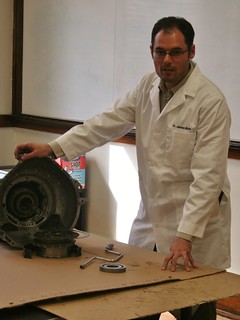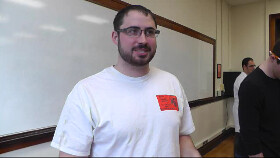Transmission Disassembly Makes For Interesting GE 410 Class
Conceptualizing Component Design
What’s the importance of watching the disassembly of an automatic transmission? Professor James Allison began doing so when students were having trouble grasping how systems work altogether. In General Engineering 410: Component Design, students learn about the design of basic engineering components. Much of the course is spent talking about individual pieces such as gears and bearings, and how they factor into a greater mechanical system.

Professor James Allison
For the past three semesters Allison has disassembled a transmission in-class. The interactive step by step procedure allows students to see an entire system, and ultimately to better conceptualize the theories from class. Allison gave his Spring 2013 class a full hour to watch him dissect the system, employing pieces from a manual transmission to emphasize the difference in shifting gears. The students examined the components at the completion of the lecture.
Student Reactions
When Professor Allison completed his demonstration his students filed to the front of the class to dig into the transmission. They picked up pieces and tried to fit components back together. Overall they were grateful to have a real life reference for the readings in their textbooks.

Senior in General Engineering Matt Anderson benefited from the connections between the transmission and the systems covered in the curriculum “We learned a lot about gears in class so when the presentation got to the meshing of the gears that coincided with what we learned, and that was definitely helpful as opposed to just learning the theories.”
Senior in General Engineering Drew Heinzmann “The transmission is a really complicated system that helps you understand how gear types apply to real life situations. Maybe now I could take one apart, but I still couldn’t put one together”

Junior in General Engineering Adam Cornell “I thought it was really neat, I’ve never seen the inside of a transmission before. I’ve taken apart bikes and that sort of thing, but nothing this complicated, it really helped to see.”
Importance of Hands-On Experience
Allison sees the value in getting students to play with mechanical systems and understand them as tangible designs because most of his students come to class lacking hands-on mechanical experience. Experience that has served Allison as foundational to his engineering career. He first began working with mechanical systems in high school autoshop, and pursued the interest to a job as a technician in a transmission shop. It wasn’t until after a few years as an assistant service manager in a car dealership that Allison applied his mechanical background to engineering at the University of Michigan (MSME ’04, MSIOE ’05, PHDME ’08).

Ford Automatic Transmission
For the class, Allison chose the automatic transmission from a Ford Van because it is one of the most complicated mechanical systems in mass production. His particular transmission was an older model, making it an even greater educational tool because of the many parts within the dated hydraulic valve body. The system was also an easy choice for Allison due to his years of experience working with older Ford and GM transmissions.

Comments - No Responses to “Transmission Disassembly Makes For Interesting GE 410 Class”
Sorry but comments are closed at this time.